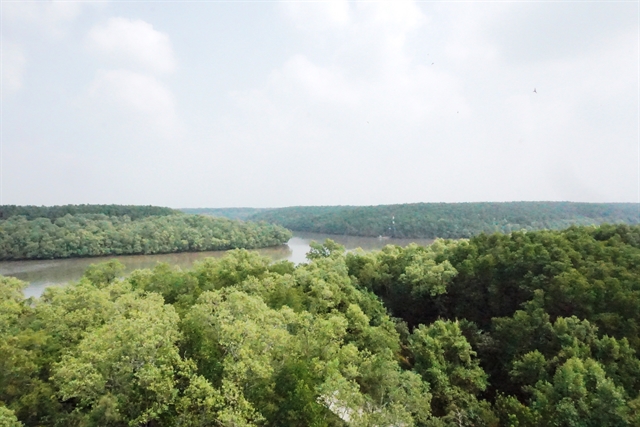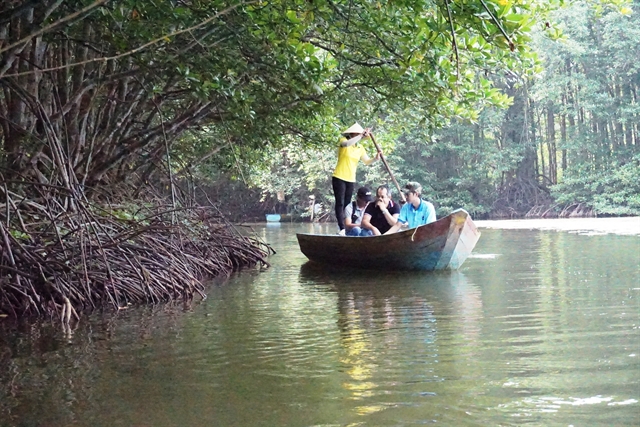 Environment
Environment

After nearly 20 years of restoration, Cần Giờ Mangrove Biosphere Reserve has become the "green lung" of HCM City, contributing to improved air quality and reduced environmental pollution in the city.

|
| A view of Cần Giờ Mangrove Biosphere Reserve in HCM City’s Cần Giờ District. — VNS Photo Thu Hằng |
HCM CITY — After nearly 20 years of restoration, Cần Giờ Mangrove Biosphere Reserve has become the "green lung" of HCM City, contributing to improved air quality and reduced environmental pollution in the city.
The People’s Committee of HCM City last month organised a seminar to review the reserve’s achievements and conservation efforts in the face of urbanisation and climate change, with the aim of building a "green wall" to protect the city’s environment.
Located 50km southeast of the city centre, the reserve covering more than 75,000ha was recognised in 2000 by UNESCO as the first Mangrove Biosphere Reserve in Việt Nam and a member of the global biosphere reserve network.
Huỳnh Đức Hoàn, head of the reserve’s Forest Protection Management Board, said the mangrove forest has a special environment comprising watershed, terrestrial, freshwater, and saltwater ecosystems.
The forest plays an important role in limiting damage caused by storms and floods, reducing up to 50 per cent of the impact of energy from ocean waves, preventing rising sea levels, and protecting local households and infrastructure along the coasts.
The forest's trees also provide firewood and raw material for production of pulp, particle boards and planks. The bark of the trees can be used to produce tannin for dyeing fabric to make glue, while leaves of mắm (Avicennia) trees are used to feed cattle.
Some parts of trees in the forest are used to make medicine. "We can use them for a long time because the trees have an ability to recover quickly,” Hoàn said.
The forest is also an important seafood source, said Associate Professor Viên Ngọc Nam of the HCM City University of Agriculture and Forestry.
There are many maritime varieties with high economic value such as sea bass, grouper, catfish, black-tiger shrimp, vannamei and blood cockle.
“Fallen leaves and parts of trees eventually decompose and become nutrient-rich humus, which is a food resource for marine animals,” Nam said.
Black-tiger shrimp, clam and shellfish breeding has developed since 1993, making an important contribution to agricultural restructuring, poverty reduction, and economic and social development, he said.
Conservation of forest resources
Nguyễn Xuân Hoàng, deputy director of the city’s Department of Agriculture and Rural Development, said the Cần Giờ Biosphere Reserve would be turned into an ecotourism zone.
The system of bridges, roads, canals, ditches and walkways in the forest have already been upgraded, creating favorable conditions for tourists to visit, he said.
In the coming time, the municipal People's Committee of Cần Giờ District will focus on investing and improving the tourism space in the forest and link it with other tourism spaces in the area.
The Forest Protection Management Board has developed a forest resource management plan that includes a focus on biodiversity conservation and sustainable development.
The board has worked with the Southern Institute of Ecology to investigate bird species in the protective forest, which will serve biodiversity conservation and eco-tourism.
Since 1990, it has signed contracts with 144 local households and 12 agencies and units and handed over forested areas to them for protection.
“This model brought good results as the forest owners have peace of mind and actively participate in forest protection,” Hoàng said.
HCM City is completing policies on management and planning of the reserve, and mobilising the participation of communities and stakeholders in the management and exploitation of forest resources.
Improving livelihoods for residents living in the reserve's buffer area will also be implemented. The city has set up forest protection posts in key areas and all sub-areas, and created relationships between forest protection forces and people living around the buffer area.
The city is also working closely with districts, communes and armed forces in forest management and protection, and further extending forest coverage as well as creating jobs for labourers participating in afforestation.

|
| Tourists take a boat trip around the mangrove forests. — VNS Photo Thu Hằng |
Tourism Urban Area Project
The Cần Giờ Sea Encroachment Project, also known as the Cần Giờ Tourism Urban Area Project, is expected to improve the quality of life of local residents and contribute to economic development, creating 25,000 jobs and adding a significant amount of revenue to the city budget.
Covering 2,870ha of land, the project is located in the coastal area of Long Hòa Commune and Cần Thạnh Town in Cần Giờ District.
When it is completed, more than 228,000 people are expected to live in the area and nine million tourists will visit each year.
Professor Nguyễn Hoàng Trí, chairman of the National Committee of Programme on Vietnam People and Biosphere, said the project is in compliance with Vietnamese law and UNESCO’s legal framework.
The project will only use the beach and the sea area located away from other waterways, and does not affect the mangrove forest or archaeological sites, he said.
It will not cause loss of residential land or lead to migration and resettlement.
Local agriculture, fishery and seafood production will not be affected, except for an area of clam farming with low productivity in the beach area.
Trí said the project’s investor must continue conducting studies on the risks of extreme weather and erosion in forested land areas to ensure ecological integrity of the mangrove forests during the long period of project implementation.
Dr. Nguyễn Chí Thành, director of the Việt Nam Forest and Wetland Research Institute, said the project would add more the land fund, contributing to the development of Cần Giờ District.
He noted that the project investor must also evaluate the environmental impact of the project, pay attention to issues related to ecosystems, and ensure that there is no negative impact on the reserve's environment and biodiversity. — VNS




